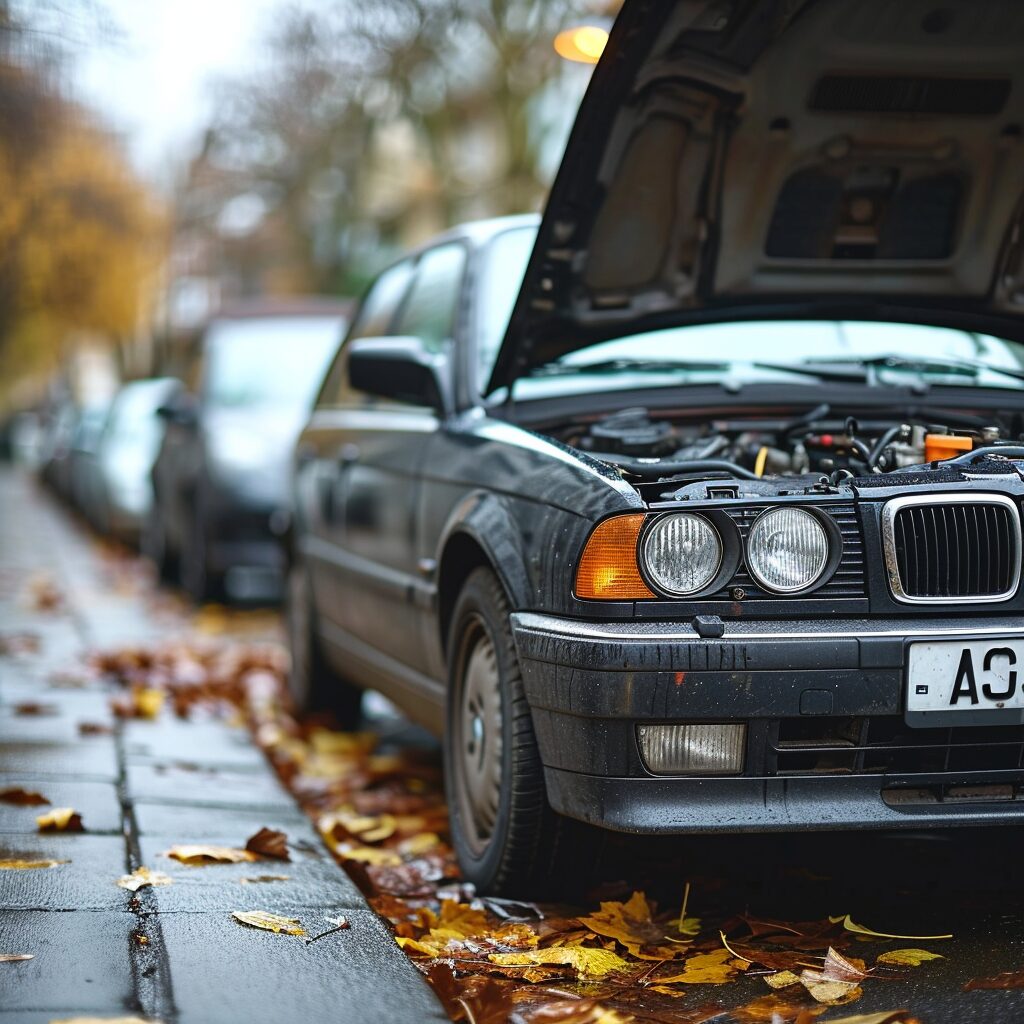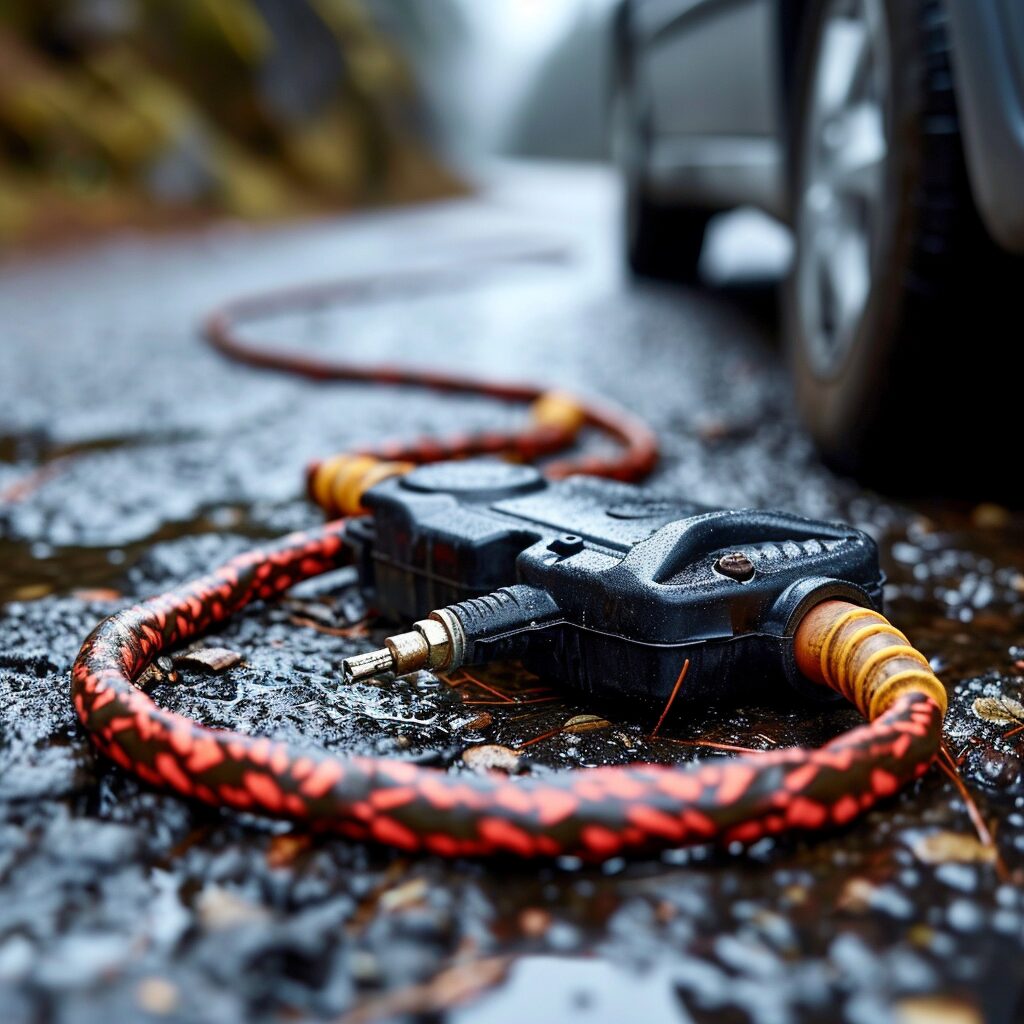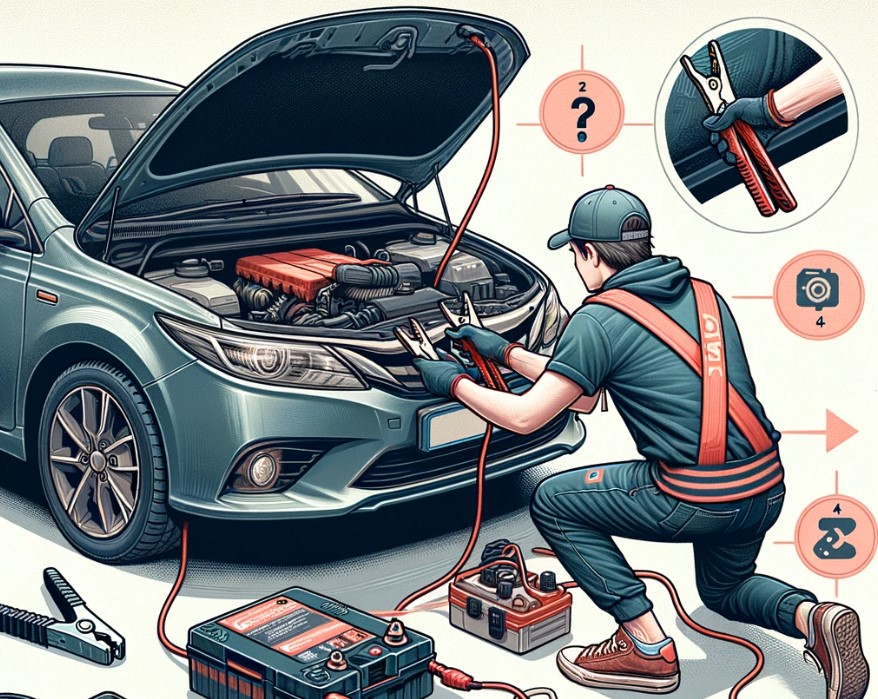So there you are, staring at your car that won’t budge because the battery decided to take a nap, and there’s not another soul with a car in sight to give you a jump. But hey, no need to throw in the towel just yet. There are some pretty clever ways to get that stubborn metal beast purring again without needing to lay a finger on someone else’s car. I’ve seen it all, from dead of winter in Canada to those ‘just your luck’ moments. And trust me, knowing how to start a vehicle that’s playing dead – without a buddy’s car – that’s a trick worth having up your sleeve.
Push start, you say? Yup, that’s on the table, but it’s just the tip of the iceberg when it comes to solo revival methods. We’ll unpack the nitty-gritty of push starting, but there’s more in the toolbox. From portable jumpers to some MacGyver-style techniques, we’ll get into how to breathe life back into that lifeless car. Buckle up, because where we’re going, we don’t need – wait for it – roads… or cables, for that matter.
Unveiling Alternative Methods to Jump-Start a Car Solo
Alright, picture this scenario: you gotta get moving but your car’s battery is deader than a doornail, and you’re solo. First things first, we’re not out of options. If your car’s got a manual transmission, push start is your friend – just a wee bit of muscle to get rolling and you might bring that engine back from the grave. But if muscle isn’t on the menu or you’ve got an automatic, don’t sweat it. There’s technology to the rescue that’ll make you miss the old jumper cable dance even less.
We’re talking gizmos that can start a vehicle without needing a jump from the kindly stranger. These gadgets are compact enough to stash in your trunk and powerful enough to wake your car from the deepest slumber. Ever been stranded with a dead battery but all dressed up with nowhere to go? With these solutions, help is as close as your trunk – no need to flag down a stranger with cables anymore.
Harnessing Portable Jump Starters for Emergency Revival
Gone are the days when a pair of jump leads and a good Samaritan’s car were your only hope for a jump-start. Enter the portable jump-starter: a little box of magic that can bring your car back from the dead without any strings – or cables – attached. It’s a real game-changer for anyone who’s ever been stuck in a parking lot with a flat battery and more pride than phone numbers to call for help.
These beauties are so simple to use, I’ll give you an easy step-by-step guide that’s as foolproof as they come. But here’s the sneak peek: positive to positive, negative to safety, power on, and start your engines. Stay tuned for the deets because I’ve seen more of these little jump box wonders save the day than cat videos have views on the internet.
Step-by-Step Guide to Using a Jump Box
Here’s a play-by-play on how to start the car with your own personal box of lightning, also known as a portable jump-starter. Start by plugging your jump starter into the wall using ac outlets – yup, just like charging your phone. Look for that symbol that tells you it’s full. Once your power source is juiced up, take the integrated cables – that’s jumper cables attached directly to the pack – and connect the red clamp to the positive terminal of the dead battery.
Now for the other side: connect the black clamp to an unpainted metal surface away from the battery. This isn’t your grandma’s knitting set; we’re talking some serious juice here, so no touching of the negative battery terminals directly. Get back in the driver’s seat, turn the key or push the button to start the car, and voila, your chariot awaits. But if the engine doesn’t start, don’t keep cranking; give the car service a call instead. And don’t forget, once you’re up and running, disconnect the clamp from the dead battery first, then the live one. Safety first, kids.
These jump boxes aren’t just one-trick ponies – nope, they’re more like a Swiss army knife for your car. Many have safety lights for night-time rescues, usb ports to charge your phone, and some even offer ac outlets. Automatic car owners, listen up: you might have heard you can’t start an automatic car with a dead battery, but these jump starter boxes say otherwise. Just be careful to not confuse your portable jump-starter with your roadside assistance – the latter won’t fit in your glovebox, and I’ve yet to see any of them with online stores.
Mastering the Art of Push Starting Your Vehicle
For those who favor the classics, push start is an oldie but a goodie, especially if you’re some of those lucky automatic car owners. Not only does it feel like a mini workout, but it’s also about as DIY as it gets. You’ll need a bit of a slope and some stamina – or just a friend who owes you one – and you’re all set to get your vehicle’s battery back into the land of the living. It’s pretty straightforward: cars in neutral, parking brake off, gather speed, pop it into gear, and hope for that sweet sound of an engine roaring back to life.
Now, I’m not saying that your beloved automatic can’t join the push start party, but let’s just say it’s not on the VIP list. Still, there are ways to trick your car to start, and as someone who’s pushed more cars than a shopping cart wrangler, trust me when I say, there’s an art to it. And if your vehicle’s got that spark of life, we’ll keep it burning bright.
Detailed Instructions for Manual Push-Start Technique
If you’re rolling with a manual transmission vehicle, then luck has already smiled upon you – push-starting is your jam. Pop the clutch pedal and it’s like flipping the ‘on’ switch, and you didn’t even have to call for a tow. Gather some friends – or kind strangers – to give that hunk of metal a shove, press down on the clutch pedal with the car in second gear, and when you hit the magic speed, release the pedal like you’re setting free a bird. That engine should chirp right to life.
It’s kinda like reviving the heart of an old friend with just a push and a prayer. But like any good technique, there’s finesse involved. Don’t try this with an automatic transmission – trust me, you’ll get nowhere fast and probably have a sore back to boot. Stick to the manual gearboxes when trying this trick, and you’ll turn a dead start into a grand departure, without needing to make awkward conversation with a tow truck driver.
Innovative Alternator Spinning Using the Fan Belt Removal Method
Now, if you’ve chased every other fix out of town and still got a stubbornly silent starter, strap in for this next one. It’s called the fan belt removal method, and it’s about as innovative as putting cheese on fries. Mechanics have been spinning alternators manually to kick a dead car battery back to life for ages. And while we’re not talking ‘turning lead into gold’ levels of alchemy here, it’s a neat trick that doesn’t come with a monthly subscription fee.
How to Manually Spin an Alternator to Recharge a Battery
So here’s the scoop: with the fan belt off, you’re gonna want to do a little dance with the alternator. Not literally, ’cause that’d be weird and mostly ineffective. But if you spin it, and I mean give it the ol’ college try, you might just create enough juice to start the car. Just remember, safety glasses on, tools in hand, and maybe save this one for when you’re not wearing your Sunday best.
It’s a bit like being in one of those TV survival shows where you gotta make fire without matches – same principle, more grease. You’ll need a good grip and maybe a wingman to hold the flashlight. If the stars align and the battery gods smile upon you, a few cranks might put enough charge back into your dead car battery to turn it over. No jumper cables? No problem. But remember, this is more MacGyver than mechanic’s manual, so use this knowledge judiciously.
The Lesser-Known Battery Tipping Technique
When you’re up the creek without jumper cables and the jump leads are just a fond memory, there’s another trick I’ll let you in on – the battery tipping technique. This is no wives’ tale; it’s a method that can coax a few more miles out of a dead car battery and save the day. Sure, not every Tom, Dick, and Harry will recommend flipping your car’s life source on its side, but when the chips are down, you’ve got to roll with the punches.
The deal is, you’ll tilt the battery gently, give it a little persuasion – I’m not talking a full-on WWE move here – just a nudge to redistribute those internal fluids like a bartender mixing a cocktail. And just maybe, that’ll get your car started. Sounds like voodoo? Maybe. But when you’re without jumper cables and the clock’s ticking, a little voodoo doesn’t sound too shabby.
Safely Tipping the Battery to Rejuvenate Its Charge
So you’re looking to give this battery tipping thing a whirl, huh? Well, buckle up, because safety’s riding shotgun on this trip. No smoking, no sparks, and definitely no victory dances until that engine is purring. Carefully disconnect the battery, avoid any metal-to-metal contact, and remember those good old jump leads are sitting this one out.
Now, lay a soft mat down – scenery’s not a must, but it helps – and gently tip the battery on its side. We’re not making a dead car battery smoothie, so no shakes or roughhousing. It’s about finesse, not force. Once you’ve shaken hands with gravity, let it stand for a minute. It’s like a timeout for electrons. Inspect for damage – because if it looks like it’s seen better days, maybe it’s best to retire this player. Then, gently lift the battery back upright and grant it a decent reconnection; red to red, black to black, no mix-ups unless you fancy a light show.
After all is in place, give the car a start. If the battery nods off again, you might be in the market for a new one. And if this technique doesn’t quite work out, console yourself with the thought that at least now you’ve got a story to tell about that one time you did something most people wouldn’t believe. Plus, with this maneuver under your belt, those flashy jump starters sold in online stores with their fancy integrated cables, usb ports to charge your phone, and whatnot seem like overkill, right?
Essential Safety Measures When Starting a Dead Battery Alone
What’s the saying? Better safe than sorry? Buddy, when you’re trying to jump-start a car solo, that should be your mantra. Because let’s face it, a car with a damaged battery can throw a fit worse than a two-year-old denied candy. If things go south, your metal steed could spit fire or even explode – and not in a cool Hollywood movie way. So let’s keep all our fingers and eyebrows where they belong, and heed some safety measures before we wrestle with that flat battery.
I’ve seen my share of would-be mechanics go into a job guns blazing, but when you attempt to start a car, especially with a battery that’s gone on strike, you’re at the mercy of the automotive gods. Make sure your jump pack is fully charged, because there’s nothing sadder than an underpowered savior. And when you connect that life-giving juice, remember: red to positive, black to not-going-to-shock-yourself-today-thank-you very much.
Safety glasses aren’t a bad idea when you’re fiddling under the hood. Neither is double-checking that all your connections are as tight as your budget after holiday shopping. And once you’ve jolted your ride back to animation, don’t break out into a touchdown dance in the middle of the highway. Instead, give it some revs, let it idle, and keep those rescue tools stowed properly, because the road’s unpredictable and you want to be ready, just like a Boy Scout with a penchant for internal combustion engines.
Precautions to Ensure a Safe and Successful Jump-Start
Alright, fellow grease monkeys, before you embark on this electrickery adventure, let’s talk safety. Your jump box is your best pal here, and it’s armed with everything necessary – jumper cables attached, safety lights to guide you, and usb ports to charge your phone if you need to phone a friend for moral support. But before you start connecting things willy-nilly, locate the ac outlets and ensure you’re not playing mix-and-match with terminals – positive to positive, and look out for that symbol to know you’re on the right track.
If the engine doesn’t start, don’t just hammer away at that ignition like you’re trying to beat the high score on a game console. Take a breather, check your connections, and if the puzzle still isn’t coming together, then call in the cavalry. But above all, remember – you’re not defusing a bomb, you’re just getting your chariot ready to ride. So keep it cool, follow the steps, and if all else fails, your trusty car’s electrical system can handle a tow to the nearest garage. Because sometimes, the best way to fight a battery is dead is with a little professional TLC.
Addressing the Risks: What You Should Never Do
Jumpstarting a battery ain’t child’s play, so heed these essential safety rules to avoid a real headache. First off, never ever charge a frozen battery; thaw it out first, unless you want a potential explosion on your hands. Also, double-check those cables before you clamp on. Links to the wrong terminals or mixing up positive and negative can zap your car’s electrical components or worse—spark a fire. That’s a mess none of us want.
And here’s one more thing—don’t think about trying to charge a cracked or leaking battery. That’s just asking for trouble. And let’s keep it straight, don’t push-start an automatic vehicle. It’s that manual transmission that might play ball with a push; automatics will just sit there looking pretty, with not a single rev to share.
Troubleshooting and Maintenance Tips
If your car’s playing dead, let’s troubleshoot. Roll up your sleeves and check for the obvious culprits: loose cables, a corrosion party on the terminals, or maybe lights left on all night. All these can damage the battery. Tighten connections, clean up corrosion with a little elbow grease and baking soda, and pray you didn’t leave those high beams on since yesterday. That’s a rookie mistake!
Regular maintenance does wonders, too. Keep an eye on the battery’s charge and make sure you don’t let ‘er sit idle for too long. Batteries, like us, need a little action to stay in top shape. A stable, healthy voltage means your car might start without a hiccup, smile, and be ready for that morning commute. Talk about driving peace of mind.
Identifying the Causes: Why Car Batteries Die
Batteries kick the bucket for all sorts of reasons. Sometimes it’s just old age—nothing lasts forever, after all. Or maybe it’s been through one too many harsh winters in The Great White North, where I come from. Cold snaps can be a battery’s worst nightmare, and summers ain’t much kinder – the heat can fry ’em like eggs on a sidewalk.
Then there’s the human factor. Forgetfulness is a battery’s sworn enemy. Leave those headlights or dome lights on, and you’re playing a one-sided game of drain the battery. Plus, if your alternator’s waving the white flag, it’s not charging the battery while you drive, and that’s a round trip to Strandedville.
Understanding Your Car’s Electrical System
Your car’s electrical system is like its nervous system, with the battery as the heart—pumping juice to all the vital parts. Alternators, spark plugs, and all those flashy dashboard lights rely on a steady stream of power. Keep it all in good health, or you’ll feel your car’s pulse weaken.
The Role of the Alternator in Your Vehicle’s Battery Health
The alternator’s your car’s unsung hero—it keeps that battery charged while you cruise. This trusty sidekick takes mechanical power from the engine and turns it into the electrical power that charges your battery. Without it, you’d be juicing up the battery more often than your smartphone.
But even heroes falter; a faulty alternator means the battery’s getting the cold shoulder, with no charge in sight. You’ll want to keep tabs on the alternator’s performance, test it at the shop if you’re suspecting something’s up. If your headlights are dimming or you’re hearing a weird whine, it’s time for a check-up.
The Importance of a Properly Functioning Fan Belt
Let’s chat about the fan belt—this isn’t just some rubber loop. It’s vital, like the belt on your pants. It drives the alternator, the power steering, the whole nine yards. If it’s loose or as broken as my first marriage, you’re not going anywhere except maybe to give your mechanic a surprise visit.
So, pay attention to squealing noises on startup or while turning—that’s your cue. A properly tensioned and intact fan belt makes sure all those spinning parts stay in harmony. It’s a small piece of the puzzle, but miss it, and you’ll know soon enough when you’re stranded and scrounging for a tow.
Resolving Common Queries About Car Battery Challenges
Got questions about dead batteries? You’re not alone. Sometimes it feels like these hunks of metal have minds of their own. Like, if you’re needing to jumpstart a battery without help, you’ll wonder if it’s even doable. Sure, with the right tools like portable jump starters, you can bring ‘em back from the dead solo.
And let’s clear up some confusion about swapping parts. Mix-and-matching batteries from different cars? Not the brightest idea, even if they look the same. When you’re picking a battery, it’s about more than size—it’s matching power, capacity, and ensuring you don’t fry the electrical components with the wrong juice.
Addressing FAQs on How to Start a Car With a Dead Battery Without Another Car
If your battery’s dead and there’s no buddy to give you a boost, don’t fret. There’s a handful of tricks to try, like portable jump-starters or the old-school push start (for those with a manual and a steep hill). But whatever you do, don’t try to MacGyver a solution if you’re not sure. Seek out a professional mechanic—it’s their bread and butter, after all.
Why Aren’t All Cars Suitable for a Push-Start?
Sure, you’ve seen it in the movies: some Joe pushes a car, pops the clutch, and vroom—it’s alive! But not every car’s cut out for the Hollywood treatment. Cars with an automatic transmission are like stubborn mules—they just won’t budge with a push. No sir, it’s the manual transmission vehicle that’s willing to dance with a push start.
And when it comes to manuals, you’ve gotta court ’em right. Position the car downhill if you can, hop in, turn the ignition on, press the clutch pedal down, and shift into second gear. Now, get those friendly bystanders pushing, release the clutch slowly, and you just might coax that engine to life.
Can Bridging Two Batteries Be a Viable Solution?
Bridging two batteries to start a car seems like something out of a MacGyver episode, but it’s a real trick. You take two same-voltage batteries, hook ’em up in parallel, and voilà, double the cranking power. Just be sure you’re not doing it with mismatched voltages or types—that’ll end with more sparks than the Fourth of July.
It’s a nifty hack if you’re in a bind, but let’s be real, it’s not for everyone. Without knowing your way around a set of jumper cables and the proper safety precautions, you could end up decorating your driveway with battery acid. If that sounds daunting, best leave it to the pros.
Aftercare: Post-Jump-Start Best Practices
You jump-started your car—kudos! But don’t hit the road just yet. Give it some time to let the alternator do its thing and recharge the battery. A quick jaunt around the block won’t cut it; think more like a long, therapeutic drive. Otherwise, you might find yourself back at square one, and that’s no fun for anyone.
After that, keep an eagle eye on how the car behaves. Any strange dimming of lights or trouble starting up again could mean your battery’s singing its swan song. And it’s worth getting your charging system checked out to make sure your battery and alternator are in harmony.
What to Do Once Your Car is Up and Running Again
So, your car’s purring again after a jump-start scare. Now, don’t just pat yourself on the back—take action. Drive around for a good half hour or so to ensure the battery gets a decent charge. And if you can, avoid turning the car off soon after you’ve started it; that can be a real drain.
Next, if you’ve had to push the car to get it going, you’ll want to shift to second gear soon after the engine catches. Keep those RPMs steady and give your car the time it needs to recover. It’s like coming back from a cold—you don’t run a marathon the next day.
Long-Term Battery Care to Prevent Future Failures
When it comes to your vehicle battery, think long-term relationship, not a fling. Show it some love with regular check-ups and keep it fully charged, especially if it’s gonna sit for an extended period. Batteries have a thing about being neglected; they tend to give up on you just when you need them most.
That means keeping tabs on the charging system, too. Ensure it’s not overcharging or undercharging the battery. Both can seriously shorten your battery’s lifespan—like feeding it nothing but candy or starving it. Balance is key; a happy battery means a happy car.
Final Insights: Empower Yourself for Battery Emergencies
Being ready for battery problems is like keeping an umbrella handy for a rainstorm—you’ll be thankful when it pours. Understand what makes your vehicle battery tick and how to keep it topped up if it’s been sitting for an extended period. Trust me, batteries have a knack for picking the worst times to quit.
And if you’ve gotta jump start your car without another in sight, don’t panic. Today’s tools and gadgets have got your back. Just remember to handle them with care, like the delicate instruments they are. Oh, and regular vehicle check-ups? Non-negotiable. They’re like going to the doc; better safe than sorry.
Equipping Yourself with Knowledge and Tools for Success
Here’s the deal: the more you know, the less you’ll sweat when battery woe hits. You wouldn’t step into a storm without a coat, right? Same goes for car trouble. Keep a portable charger handy, familiarize yourself with your car’s quirks, and you’ll be ready to roll whenever, wherever.
And it doesn’t hurt to have a few tools in your trunk—jumper cables, a wrench set, maybe even a multimeter. With the right gear and a little know-how, you’ll turn a breakdown into nothing more than a bump in the road. That’s not just smart; it’s streetwise.
The Importance of Regular Vehicle Check-Ups to Avoid Dead Batteries
Now, let’s talk brass tacks. Regular vehicle check-ups are like having an insurance card against the headache of dead batteries, and they’re a lot simpler than trying to jump start a car without another. I’ve seen too many folks wait until their ride’s dead in the water before they even think about the battery. That’s like waiting for a blizzard to hit before you buy a shovel, my friends. By keeping up with your car’s health, you’re going to make sure that alternator isn’t slacking and the battery holds a charge like it’s clinging to the last slice of pizza.
During these check-ups, I always recommend wearing safety glasses and non-conductive mechanic gloves because, believe it or not, cars can throw curveballs. And let me tell you, an unexpected spark or battery acid mishap isn’t fun for anyone. We also make sure the battery charger’s doing its dance properly and keeping that juice flowing. Look, the bottom line is, cars need love too, and the more you give them, the less likely you are to find yourself stranded with a dead battery out in the cold, wishing you had listened to good ol’ reliable me.

















